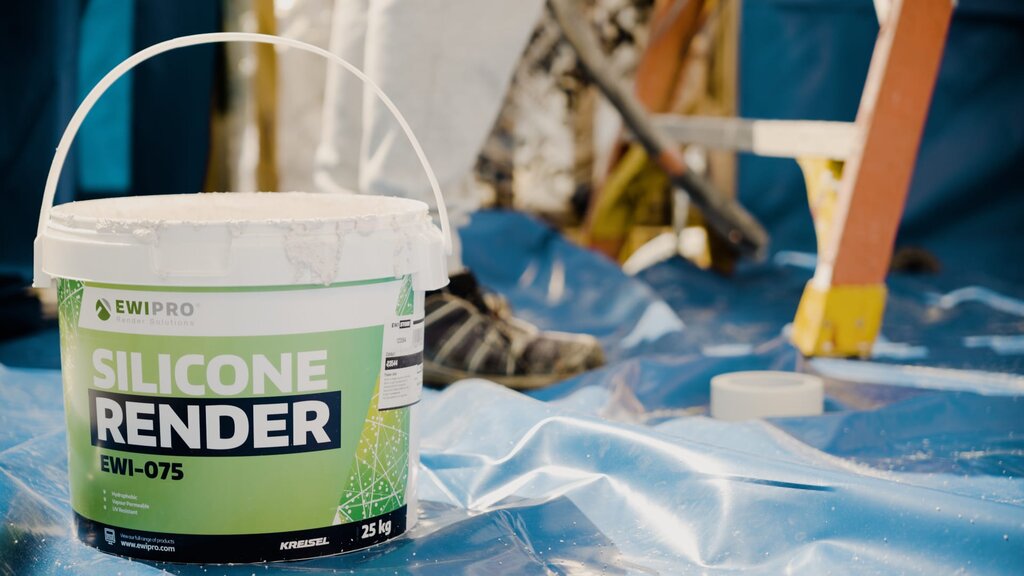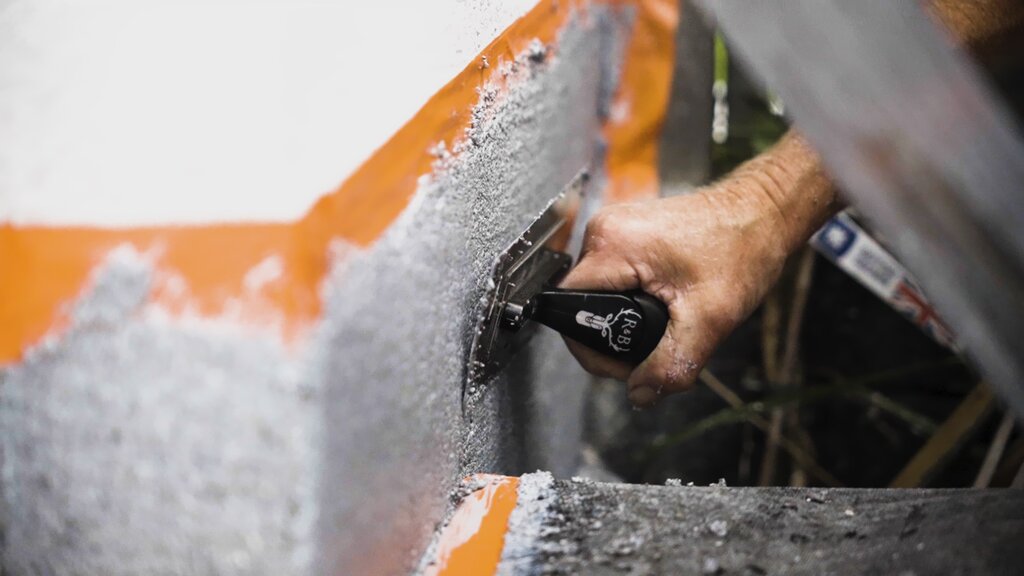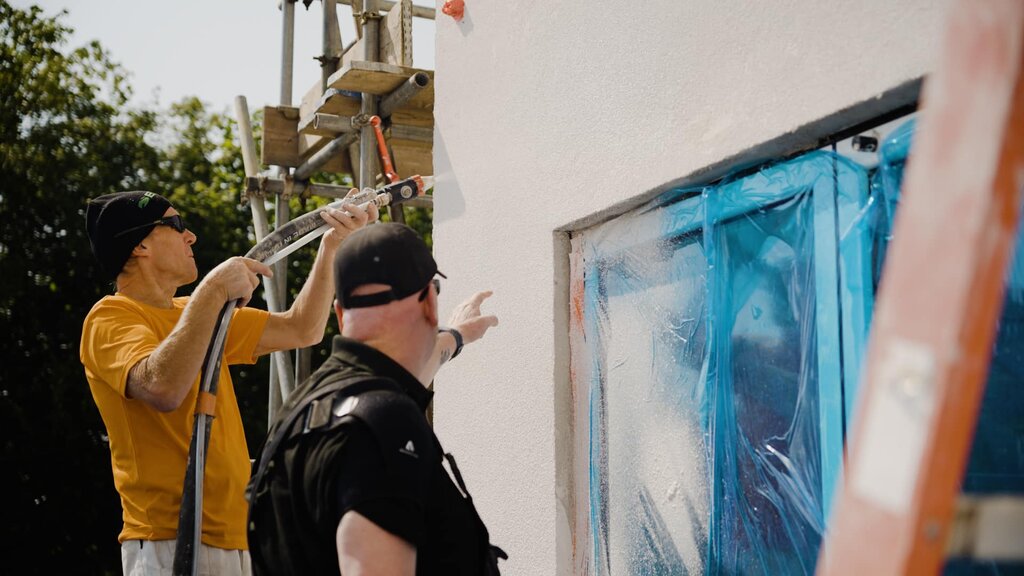
- Types of render
- Silicone render
- Benefits:
- Monocouche render
- Benefits:
- Mineral render
- Benefits:
- Mosaic render
- Benefits:
- Sand & cement render
- Benefits:
- Lime render
- Benefits:
- Ways to apply render to a wall
- Trowel application
- Detailed process:
- Benefits:
- Spray Machine Application
- Detailed process:
- Benefits:
Applying render to a building is critical to its aesthetic appeal and protection. Whether you're a professional or a DIY enthusiast, understanding the different types of render and their application methods is essential for achieving the best results. In this comprehensive guide, we’ll explore various render types, including silicone, monocouche, mineral, mosaic, sand and cement, and lime, and delve into the application techniques such as a trowel and spray machine application.
Types of render
Silicone render
Silicone render is a through-coloured render that stands out for its advanced properties and finishes. It comprises a blend of silicone resin, pigments, and fillers, offering a unique combination of durability and aesthetic appeal. Silicone render is a remarkable material that skillfully balances practicality and aesthetics. Its water-repellent nature ensures that water simply beads off its surface, preventing the walls from absorbing moisture and thereby reducing the risks of dampness and water ingress. Simultaneously, this render type is breathable, allowing internal moisture to escape, which is crucial in averting damp and mould build-up. Adding to its impressive features, silicone render exhibits a high degree of flexibility, making it less prone to cracking caused by building movement or thermal expansion. This flexibility also contributes to its low maintenance requirements, as the render effectively resists dirt, algae, and fungal growth, maintaining its appearance over time with minimal upkeep. Moreover, silicone renders are known for their excellent colour retention, resisting the effects of UV rays to prevent significant fading and ensuring that the building's aesthetic appeal is preserved for a longer duration. Additionally, it provides a range of texture options, from smooth finishes to more coarse textures, offering ample room for customisation to achieve the desired look. This blend of functional benefits and aesthetic versatility makes silicone an outstanding choice for a wide array of building projects.
Benefits:
- Longevity: Thanks to its durable properties, silicone render lasts longer than many traditional renders, reducing the need for frequent reapplication.
- Aesthetic Flexibility: Available in a wide range of colours, it provides significant flexibility in design and can be tailored to suit various architectural styles.
- Energy Efficiency: The render can contribute to thermal efficiency, as it helps to keep the building envelope dry, improving insulation properties.
- Application Ease: It can be applied to a range of substrates, including brick, block, and even over existing render, making it versatile for new builds and refurbishments.

Monocouche render
Monocouche render, often perceived as a modern and straightforward rendering solution, actually involves a more nuanced application process than its 'single-coat' label might suggest. While it is true that monocouche render is known for its thick consistency and ability to cover surfaces effectively, professional application typically involves two layers. This two-layer process ensures optimum coverage, durability, and finish, contrary to the common misconception of it being a one-layer system. The initial layer of monocouche render acts as a base coat, adhering well to the substrate and providing a stable foundation for the top layer. The second layer is then applied to achieve the final thickness and texture. This layering technique, while still simpler than traditional multi-coat renders, allows for better control over the finish and overall quality of the rendering. The render is pre-coloured, which streamlines the process by eliminating the need for post-application painting and also guarantees a consistent colour throughout.
Benefits:
- No Painting Required: As it is pre-coloured, there's no need for additional painting, offering convenience and a uniform finish.
- Durable: Highly resistant to weathering and wear, ensuring longevity.
- Breathable: Allows moisture to escape from the building, reducing the risk of dampness and mould.
- Versatile in Finishing: This can be used to achieve a variety of textures and looks to suit different architectural styles.
- Aesthetic Appeal: Offers a crisp, clean appearance with a variety of colour options, enhancing the building's exterior.
- Low Maintenance: Requires minimal upkeep due to its robust nature and resistance to common issues like algae and mould growth.

Mineral render
Mineral render, a distinct and efficient option in the rendering world, offers specific advantages that make it particularly appealing for certain building projects. One of the key characteristics of mineral render is its fast-drying properties. This aspect is especially beneficial in climates or seasons where the weather can be unpredictable, allowing work to proceed without long delays for drying. EWI Pro mineral render exemplifies this feature, ensuring a swift setting process that can be advantageous in time-sensitive construction schedules. Another significant aspect of EWI Pro mineral render is its A1 fire rating. This rating indicates that the material is non-combustible, making it an excellent choice for projects where fire safety is a paramount concern. The use of non-combustible materials in construction is increasingly important, particularly in multi-storey buildings, and mineral render meets these stringent safety standards without compromising on quality or aesthetic appeal. Mineral render requires a paint finish to seal in the weatherproofing qualities. This paint finish can also be selected to complement the building's design or to align with specific aesthetic or branding requirements.
Benefits:
- Fast-Drying: Ideal for quick application and suitable for use in less predictable climates.
- A1 Fire Rated (EWI Pro): Offers superior fire safety, making it a safe choice for a variety of building types.
- Flexible Aesthetic: Requires a paint finish, providing an opportunity to customise the final appearance.
- Durability: Resistant to a range of environmental factors, ensuring longevity.
- Breathable: Allows moisture to escape from the building, reducing the risk of dampness and mould.
- Eco-Friendly: Often made with natural materials, making it a more sustainable choice.
- Suitable for Various Substrates: Can be applied to a wide range of surfaces, enhancing its versatility.
Mosaic render
Mosaic render stands out in the rendering world for its unique aesthetic and functional properties. This type of render is particularly notable for its inclusion of aggregates, which are integral to its texture and overall appearance. These aggregates, typically consisting of small, coloured pieces, are embedded in the render, providing a distinctive, granular texture that is both tactile and visually appealing. The incorporation of these aggregates not only enhances the render's aesthetic but also contributes to its durability. A key application of mosaic render is its suitability for use under the Damp Proof Course (DPC) of buildings. The DPC is a critical area in construction, designed to prevent rising dampness, and the mosaic render's robustness makes it an ideal choice for this purpose. Its texture and composition offer an extra layer of protection against moisture ingress, which is particularly important in areas close to the ground where dampness is more prevalent.
Benefits:
- Durable Texture: The inclusion of aggregates in the render provides a hard-wearing, textured surface.
- Ideal for Under DPC: Suitable for use in areas prone to dampness, providing an additional protective layer.
- Low Maintenance: Resistant to environmental factors, reducing the need for frequent upkeep.
- Versatility: Can be used in a variety of architectural styles, from modern to traditional.
- Moisture Resistant: Offers protection against moisture ingress, crucial for lower sections of buildings.
- Long-Lasting Finish: Maintains its appearance over time, even in challenging weather conditions.

Sand & cement render
Sand and cement render is a time-tested solution in the world of construction, revered for its simplicity and effectiveness. This traditional type of render is a mixture of sand, cement, and often lime, which collectively create a hard-wearing and versatile plaster. The blend of these materials can be adjusted to suit different substrates and climatic conditions, making sand and cement render a flexible option for a wide range of building projects. One of the key characteristics of sand and cement render is its robustness. Once applied and cured, it forms a solid, durable layer that provides excellent protection against various environmental factors. The inclusion of lime in the mixture not only aids in flexibility, reducing the risk of cracking but also enhances the render's breathability. This is particularly beneficial for older buildings or those constructed with materials that need to 'breathe', as it allows moisture within the walls to escape, thereby reducing the potential for dampness and related issues. Despite being a more traditional option, sand and cement render can be finished in a variety of ways to achieve different textures and appearances. From smooth finishes to more textured surfaces, this type of render can also be tailored to match the desired aesthetic of a building. It is also typically painted after application, offering further opportunities for customisation in terms of colour and finish.
Benefits:
- Durability: Forms a hard and protective coating that withstands environmental challenges.
- Versatility in Finish: This can be tailored to achieve a range of textures and subsequently painted for colour customisation.
- Flexibility: The inclusion of lime reduces the risk of cracking.
- Breathable: Allows moisture to escape from the walls, making it suitable for older buildings.
- Cost-Effective: Generally more affordable than some modern alternatives.
- Adaptable to Various Substrates: Can be applied to a wide range of building materials.
- Time-Tested: Proven performance over many years in various climatic conditions.
Lime render
Lime render is a traditional and environmentally friendly rendering option.It is often chosen for its natural properties and compatibility with older, historic buildings. Made primarily from lime, mixed with sand and water, lime render is known for its high breathability and flexibility, making it particularly well-suited for buildings that require a delicate approach to moisture management and structural movement. The breathability of lime render is one of its most significant features. It allows moisture to escape from the structure, preventing problems associated with dampness, such as mould growth and structural damage. This characteristic is particularly beneficial for older buildings. These often have solid walls that need to 'breathe' to release internal moisture effectively. Another key aspect of lime render is its flexibility. It is more accommodating of building movement than harder renders, such as cement, reducing the risk of cracking. This flexibility is vital for older buildings, which may settle and shift over time. In terms of aesthetics, lime render offers a traditional, soft, and often textured finish that can be very appealing, especially on heritage buildings. It can be left natural or coloured with pigments, providing a range of visual options. Over time, lime render develops a patina that many find aesthetically pleasing, also adding character to the building.
Benefits:
- High Breathability: Allows moisture to escape, preventing dampness and related problems.
- Flexibility: Accommodates building movement, minimising the risk of cracks.
- Environmentally Friendly: Made from natural materials, lime render is sustainable and eco-friendly.
- Aesthetic Appeal: Offers a traditional, soft look that ages gracefully.
- Suitable for Historic Buildings: Compatible with the structural and moisture requirements of older properties.
- Natural Fungicide and Bactericide: Lime is naturally resistant to mould and bacterial growth.
- Customisable Finishes: These can be left natural or coloured with pigments for a range of appearances.
Ways to apply render to a wall
The application of render is a crucial stage in the construction or renovation process, dictating not only the aesthetic appeal of a building but also its protective qualities. There are primarily two methods of applying render: trowel application and spray machine application.
Trowel application
Trowel application is the traditional method of applying render. This method involves the manual application of render using a trowel, where the tradesperson spreads, smooths, and finishes the render by hand.Detailed process:
- Preparation: The surface is first prepared to ensure it is clean, dry, and free of any loose material.
- Mixing: The render mix is prepared according to the manufacturer’s specifications. This might involve mixing dry ingredients with water to achieve the right consistency.
- Application: Using a trowel, the render is applied to the wall in smooth, upward strokes. The thickness of the application depends on the type of render and the desired finish.
- Finishing: Once applied, the render is smoothed out and finished. Different techniques, such as floating or texturing, can be employed to achieve various finishes.
Benefits:
- Control: Provides a high level of control over the finish.
- Versatility: Suitable for a wide range of renders and finishes.
- Traditional Appeal: Ideal for achieving classic render finishes.
- Precision: Allows for precise application, particularly in intricate areas.
Spray Machine Application
Spray machine application is a more modern approach, involving the use of a specialised machine to spray the render onto the wall. This method is faster and can also cover large areas more efficiently, making it ideal for bigger projects.Detailed process:
- Preparation: Similar to trowel application, the wall surface must be prepared.
- Mixing: The render is mixed, often in larger quantities, and loaded into the spray machine.
- Application: The machine sprays the render onto the wall in even layers, controlled by the operator.
- Finishing: Once applied, the render may still require some manual finishing to achieve the desired texture.
Benefits:
- Efficiency: Covers large areas quickly, saving time on big projects.
- Consistency: Provides a more uniform layer of render.
- Labour Saving: Reduces the physical labour involved in the manual application.
- Versatility: Can be used with various types of render.

